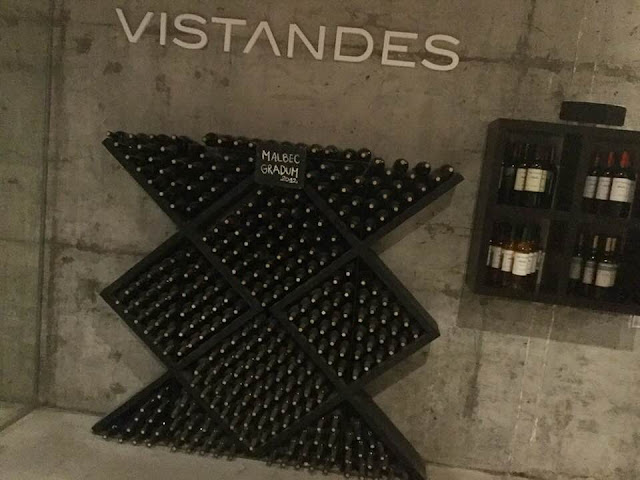Si no vino a beber vino ¿por qué vino?
If you did not come to drink wine, why did you come?
Mendoza Folk Wisdom
(It sounds better in Spanish, even if you don't speak Spanish.)
(It sounds better in Spanish, even if you don't speak Spanish.)
Part 2 of our #malbeclipse adventure took place in Argentina. We described the reasons for this journey almost two years ago in Malbeclipse 2019, and we are very grateful that we were able to follow through on this dream. Most of the photos in this post are by Pam; see James' Malbeclipse 2019 album on Flickr for his photos, some with annotations. To read about the Chile portion of our explorations, see Malbeclipse Part 1.
Most of the wine we drink in Casa Hayes-Boh is Malbec from Mendoza. A few years ago, we realized that this grape goes with just about everything, as the many Malbec references on our recipe blog attest. From some cursory exploration online and from our experience in the aisles of local wine stores, we knew that Mendoza is home to many vineyards, and that Malbec is very important there. We had no idea just how true this would be. On arrival at our hotel the first night, the simple restaurant in the lobby turned out to have an extensive wine list, including a couple dozen Malbecs from Mendoza.
We quickly realized that the choices were overwhelming, and also that we could waste a lot of time driving aimlessly about to wineries that might not have any openings on their tours. Pam noticed that quite a few agencies in the city book winery tours, so we visited one of those agencies our first morning. We had an excellent short tour that afternoon, a longer tour with an incredible lunch the following day, and found our own way to a vineyard on our third day. Some of the highlights are below.
From one of the tour bus, Pam noticed a graffito with a dramatic take on a familiar theme --
 |
| Graffiti in Mendoza "Meat is Death"; "Dairy is Rape" |
Thus our first afternoon brought us to the lovely Vistandes (get it?) winery, where we started to gain an understanding of just how much Malbec a typical operation produces in Mendoza, as well as another winery, an olive-oil factory, and an historic church.
We visited the Trapiche winery to begin our second day of touring. Seeing this brand so often at home, we were not surprised to find that it is one of the oldest and biggest of the Mendoza wineries.
 |
| Iscay is the Incan word for two - used to name this blended wine |
 |
| A canary in a coal mine problems with the rose bushes indicate a problem with the soil that needs to be addressed |
 |
| Looks like George Jetson lives here; compare below |
 |
| The press is called a trapiche enthusiastically shown here by our guide; the company derives its name from the press. |
 |
| Ants are as important for organic wine as they are for organic coffee; they are honored at the entrance to the Trapiche visitors' center. |
From Trapiche, we went to the Familia Zuccardi bodega, which is actually a collection of various wine projects of this extensive family. The main tasting room was quite busy -- with dozens of visitors at each tasting -- and serves as a small gallery for some very talented local art students.
It was here that we had a fantabulous lunch with countless courses and three wine glasses that were never allowed to sit empty for long. We shared a table with fellow tourists from Argentina, Uruguay, and Brazil, all of whom were surprised that we could carry on a conversation in Spanish (with some Portuguese).
On the third day we drove south on our own, using old-school GPS to find our way to the Bodega Salentein in the famous Uco Valley, about an hour's drive to the south of the city.
We hoped to have lunch there, but its restaurant was booked solid in the dead of winter. Views of the Andes were the best we had seen from any of the vineyards. It turns out the Uco and Mendoza are valleys in the sense that Tucson is -- meaning not really valleys at all.
 |
| Salentein has lovely views |
Instead of a tour, we enjoyed an excellent glass each and enjoyed the views. We then visited its famous -- and free -- art galleries. They include this fun piece that tempted us to break the no-photo rule (which we had conveniently not noticed).
 |
| Having fun at Salentein Winery and Art Gallery Uco Valley Mendoza, Argentina |
The Chilean portion of our travels had its theme songs; for this one, only the UB40 classic comes to mind. Best listened to without the official video, which is garbage.
One last thing: we did not expect to see llamas or alpacas on this trip and for the most part we did not. We saw one from a bus window, plus these on currency worth about 50 cents.

One map records the important sites for both parts of our adventure -- where we stayed, where we ate, where we toured vineyards (and the like) and where we were when we saw the sun blink out for 2-1/2 minutes.
Also see Pam's StoryMap featuring photos of our trip.
Also see Pam's StoryMap featuring photos of our trip.
To read about the Chile portion of our explorations, see Malbeclipse Part 1.
Lagniappe
We made this entire journey without knowing about this key bit of nomenclature, courtesy of Terrible Maps:








































































